北师大版高中英语必修二第6讲:Unit5 Rhythm-语法篇(学生版)
最新北师大版高中英语必修2 Unit 5《Rhythm》(Period 5)ppt课件
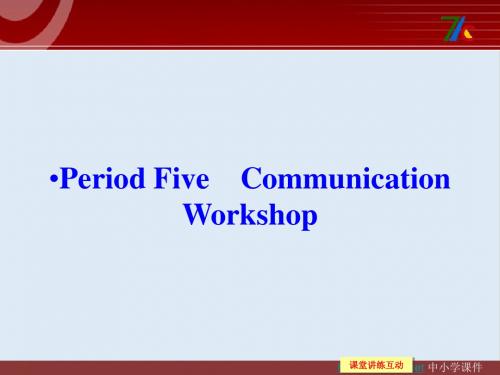
反应。
htt课p:堂//c讲a练i.7互cx动 中小学课件
• 【拓展】 • react v.反应,回应 • react to sb/sth对……作出反应,回应 • react against sb/sth反对,反抗,抗拒…… • react on/upon...对……有影响 • react with...与……起化学反应
• 6.be afraid of __担__心_,__害_怕____
• 7.the stage design 舞台_设_计__________
•
8.audience
观众反应
reaction谈到_;_涉__及________
• 9.refer to _______与_…__…_相_关
• 10.be related to ____________
去还很健壮。
• ________ ________ ________ ________ ________,he looks very strong and healthy.
htt课p:堂//c讲a练i.7互cx动 中小学课件
• 2.It was a very cold night.However,there was not an empty seat in the concert hall.
htt课p:堂//c讲a练i.7互cx动 中小学课件
• 注意:responsible作“需负责任的,应负责 任的”讲时,不可置于名词前。作“可靠的, 可信任的”讲时,可以放在名词前修饰名词。
• Who's responsible for this terrible mess? • 谁应该对这一团糟的局面负责?
Unit 5 Rhythm Period Three Grammar 课件(北师大版必修2,课标通用)

到„„就„„”;“„„才„„”;“趁着还没„„就„„”;
“还没来得及„„就„„”等。 We had sailed four days and four nights before we saw land. 我们航行了四天四夜才看到陆地。 We hadn't run a mile before he felt tired.
我们跑了还不到一英里他就累了。
Please write it down before you forget it. 趁你现在没忘把它记下来。
重点语法精析
Before I could get in a word,he had measured me.
我还没来得及插话他就给我量好了尺寸。
Before they reached the station,the train had gone. 他们还没到达火车站,火车就已开走了。
重点语法精析
【辨析】 before/since before 可 构 成 句 型 : “ it will(not)be...before” 和 “ it was
(not)...before...”,意为“多久之后才„„”。
It will be half a year before I come back. 还要半年我才回来。 It won't be long before we meet again. 过不了多久,我们又会见面。
重点语法精析
4.while和as都可译为“在„„期间;正当„„时”,表示主句中
的动作和从句中的动作同时发生。但while从句中的谓语动词通常 是持续性动词,而as从句中的谓语动词既可是持续性动词,也可是 短暂性动词。 Please don't talk so loud while others are working. 其他人工作时,请你们不要高声谈话。 While I was wondering at this,our schoolmaster took his place.
北师大版英语必修二Unit5Rhythm

看到博物馆已经关门,我们感到很沮丧。③At first glance,I was a little disappointed with Han’s own short story.乍一看,我对韩寒的小说有点失望。
看到博物馆已经关门,我们感到很沮丧。
①The “Flower Band”will give tw
③Some robots can perform operations;others can manage housework.一些机器人能做手术,另一些还会干家务活。④Learn to forget about the calls and concentrate on your performance.要学会忘记喝彩声,把精力放在表演上。
anger
15.He was__________(生气的)and hi
1.________________ 摇滚乐2.________________ 习惯于3.________________ 换句话说4.________________ 有时,不时5.________________ 在某些方面
①(2010·高考福建卷)Television’s most
把这些变化落到实处不会是件容易的事。③New mobile phone law comes into effect on September 1,2012.新的移动电话法案将于2012年9月1日生效。
把这些变化落到实处不会是件容易的事。
2 disappointing adj.令人失望的(教材P22)The music was brilliant but the special effects were disappointing. 音乐很美妙但特效却令人失望。
高中英语 Unit 5 Rhythm Period 6 Grammar课件 北师大版必修2
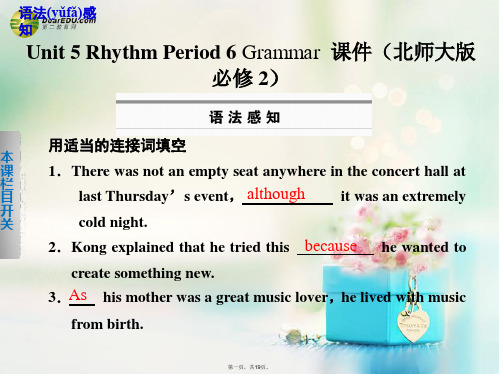
数名词
第十五页,共19页。
知识(zhī shi)储备
There are so many stars in the universe that it is
impossible to count them all. 宇宙里星星多得无法数清。
He made such an excellent speech that everyone admired
关 省略。
(3)though 引导的让步状语从句可以倒装也可以不倒装,倒
装时用法同 as。此外 though 还可用作副词,常置于句末,意为
“可是,不过,然而”。
第八页,共19页。
知识(zhī shi) 储备
Although it’s raining,they are still working in the field. 虽然在下雨,但他们仍在地里干活。
开
关
cold night.
2.Kong explained that he tried this because he wanted to
create something new.
3.As his mother was a great music lover,he lived with music
from birth.
You have to go on,whatever/no matter what difficulties
you meet. 无论遇到什么困难你都得继续下去。
第九页,共19页。
知识(zhī shi) 储备
[题组训练 2]
(1)一句多译
尽管他是个孩子,他却懂得很多。
本
① Child as he is,he knows a lot.
5 Rhythm精讲课件 北师大版必修2课件
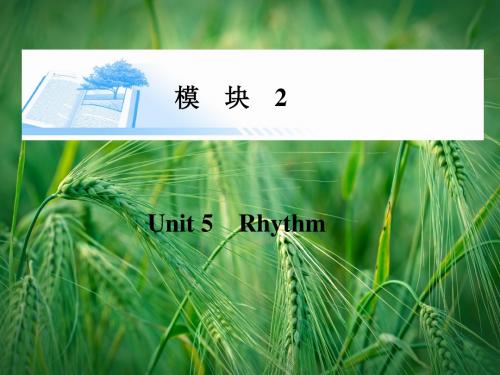
impressive adj.给人印象深刻的
impress sb.打动某人/给某人留下深刻印象 sb.be impressed by/with sth. 某物给某人留下深刻印象 give/make/leave an impression on sb.给某人留下印象
高考总复习•英语(北师大版)
用impress的适当形式完成下列句子。 (1)His words are strongly ________ on my memory. (2)I ________________________ ( 给我留下了深刻的印象 )the change brought about by the project. (3)The little girl has a gift for painting and her works have made a deep ________ on me. (4)This is the most ________ architecture I've seen on this trip. 答案: (1)impressed (2)was deeply impressed with/by (3)impression (4)impressive
(3)In fact , I________ dream about one day being a famous football player and representing my country in the World Cup. (4)He usedn't to go swimming in this river,______he? 答案:(1) get used to (2)be used to (3)used to (4)used/did
高中英语Unit5RhythmPeriod 件北师大版必修2

Para. 1
a.Kong's early life
Para. 2
b.Kong's new look
Para. 3
c.Kong's latest concert
Para. 4
d.Kong's rediscovery
Para. 5
e.Kong's success today
答案:Para. 1—c Para. 2—a Para. 3—d
③give out 发出,耗尽
④give off
放出;发出
⑤give away 赠送
课文预读
孔祥东尝试民间音乐 [第 1~2 段译文] 上星期,著名古典音乐钢琴家孔祥东以一场将古典音乐与中 国民间音乐相结合的演奏会让他的乐迷们感到惊喜。孔祥东解释 他这样做是因为他想创作某些新的东西。孔祥东说:“作为一个 音乐家,在世界上不同的城市演奏同一种音乐是非常枯燥的。” 他还觉得,用钢琴演奏中国民间音乐有助于使它走向世界。
This is why he went back to his roots and rediscovered
the beauty in Chinese folk music.
这就是他追根寻源,重新发现中国民间音乐之美的原因。
4.whether...or...无论/不管……还是……
Whether Kong is changing his appearance
11. appearance n. 外貌,外观→appear vi. 出现→ disappear vi. 消失
12.transform vt. 转换,转化→ transformation n. 转变, 转化,改造
13. pianist n. 钢琴家,钢琴演奏者→piano n. 钢琴
高中(北师大版)英语必修2课件:Unit 5 Rhythm5
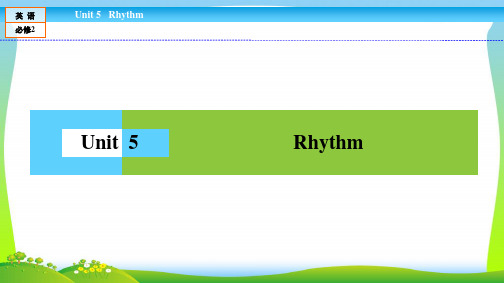
英语 必修2
Unit 5 Rhythm
词汇积累 1.response n.& vi.回答,回应 2.album n.唱片 3.more than 超过, 多于 4.altitude n.高度 5.include v.包括 6.keep busy with 一直忙于……
英语 必修2
Unit 5 Rhythm
英语 必修2
Unit 5 Rhythm
“Let’s shoot a music video in space!” Bieber said in response. Bieber,19,is the latest in a line of people who are planning a trip to space through Virgin Galactic’s SpaceShipTwo,which will take people 62 miles above Earth in a six-passenger spaceship (宇宙飞船).
英语 必修2
Unit 5 Rhythm
Unit 5
Rhythm
英语 必修2
Unit 5 Rhythm
欧美流行乐坛小王子贾斯汀·比伯宣布,将与众明星一起加入理查德·布兰森 的维珍银河太空计划,搭载航天器进行地球轨道航天旅行。
英语 必修2
Unit 5 Rhythm
Justin Bieber plans to go to space
英语 必修2
•
9、要学生做的事,教职员躬亲共做; 要学生 学的知 识,教 职员躬 亲共学 ;要学 生守的 规则, 教职员 躬亲共 守。20 21/7/2 62021/ 7/26Monday, July 26, 2021
必修二 Unit 5 Rhythm 2021届北师大版高考英语词汇插册复习PPT课件

10
必修二 Unit 5 Rhythm 2021届北师大版高考英语词汇插册 复习PP T课件
必修二 Unit 5 Rhythm 2021届北师大版高考英语词汇插册 复习PP T课件
高频考词用法
11
必修二 Unit 5 Rhythm 2021届北师大版高考英语词汇插册 复习PP T课件
高频考词用法
7
必修二 Unit 5 Rhythm 2021届北师大版高考英语词汇插册 复习PP T课件
理解拓展词汇
Base Represent Disappoint
All the time Be used to Appearance Talent Perform
必修二 Unit 5 Rhythm 2021届北师大版高考英语词汇插册 复习PP T课件
高频考词用法
【题组训练】
put to user's
必修二 Unit 5 Rhythm 2021届北师大版高考英语词汇插册 复习PP T课件
no use
to recognize grilling
up in into
15
必修二 Unit 5 Rhythm 2021届北师大版高考英语词汇插册 复习PP T课件
18
必修二 Unit 5 Rhythm 2021届北师大版高考英语词汇插册 复习PP T课件
高频考词用法
【题组训练】
必修二 Unit 5 Rhythm 2021届北师大版高考英语词汇插册 复习PP T课件
on/upon
having a great effect
took effct on/upon
into effective
19
必修二 Unit 5 Rhythm 2021届北师大版高考英语词汇插册 复习PP T课件
高中英语Unit5RhythmPeriodSixGrammar1课件北师大版必修2
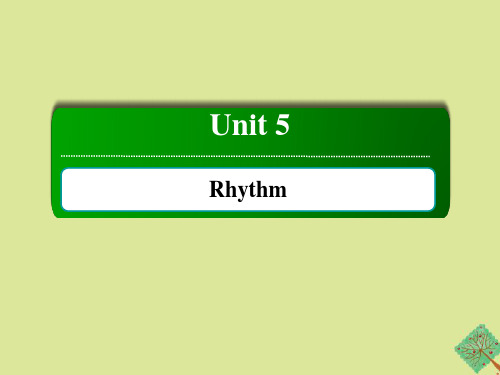
Rhythm
Period Six Grammar
单元语法(一)——will 表“决定”和状语从句(Ⅰ)
01 课前自主领悟
02 课堂语法精讲
01 课前自主领悟
[语法图解]
[语法感悟] 1.There was not an empty seat anywhere in the concert hall at last Thursday's event, _____a_lt_h_o_u_g_h_/t_h_o_u_g_h_____ it was an extremely cold night. 2.____T_h_e_f_i_rs_t_t_im__e__ you listen, try to get the general idea and
[即学即用 3] 单句语法填空 1.He tried his best to solve the problem, __h_o_w__e_v_er__ difficult it was. 2.We will make a trip even ___i_f/_th_o_u_g_h_ the weather is bad. 3.__W_h_e_t_h_e_r__ you believe it or not, it's true. 4.Clever __as_/_th_o_u_g_h__ he is, he doesn't study well. 5.She looks pretty, ___w_h_a_t_e_v_er_ she wears.
二、让步状语从句 在主从复合句中作让步状语的从句叫作让步状语从句。让步 状语从句的引导词有 although, though, whether...or..., even if, even though, as,疑问词-ever 和“no matter+疑问词”等。让步 状语从句可置于主句之前也可置于主句之后。
高中(北师大版)英语必修2课件:Unit 5 Rhythm5.6

•14、孩子在快乐的时候,他学习任何东西都比较容易。 •15、生活即教育,社会即学校,教学做合一。
探究语法精要
课时语法专练
课时语法专练
•16、当在学校所学的一切全都忘记之后,还剩下来的才是教育。2021年10月26日星期二2021/10/262021/10/262021/10/26
4.尽管他学习很努力,但几乎没取得什么进步。
Hard
,he makes little progress.
答案: as/though he works
5.无论你是否相信,这都是真的。
,it’s true.
答案: Whether you believe it or not
6.I don’t really like the author,
I will wait for my friend till/until he comes. 我要一直等到我朋友来。 We won’t start our discussion till/until he comes. 我们要等到他来了再开始我们的讨论。 名师点津:在含有时间状语从句的复合句中,从句通常用一般现在时代替 一般将来时,用一般过去时代替过去将来时,用现在完成时代替将来完成时。
课时语法专练
Ⅰ.用适当的连词填空
1.It will be a long time
we finish this dictionary.
答案: before
2.
he came to China,Mr Green has worked in this company.
答案: Since
3.
the bell rang,all the students stopped talking.
高考英语一轮复习 Unit 5 Rhythm讲义 北师大版必修2

Unit 5 Rhythm一、刷黑板——词汇全听写先过识记默写关Ⅰ.阅读词汇(英译汉)[第一屏听写]1.jazz n.爵士乐2.*rock ‘n’ roll 摇滚乐3.*disco n. 迪斯科舞4.ballet n. 芭蕾舞5.*clown n. 小丑6.*acrobatics n. 杂技7.*costume n. 戏装;服装[第二屏听写]8.*waltz n.华尔兹舞9.*breakdance n. 霹雳舞10.*encyclopedia n. 百科全书11.*peacock n. 孔雀12.Swan Lake (芭蕾舞剧)天鹅湖13.tap dancing 踢踏舞14.*tango n. 探戈舞[第三屏听写]15.skip n.跳,蹦16.*realistic adj. 现实(主义)的17.audience n. 听众;观众18.instrument n. 乐器;工具19.sword n. 剑20.hairstyle n. 发型21.mask n. 面具,面罩Ⅱ.高频词汇(汉译英)[第四屏听写]1.folk_adj. 民间的2.effect n. 效果,作用3.disappoint vt. 使失望4.extraordinary_adj. 非凡的,特别的5.unclear_adj. 不清楚的6.be_used_to 习惯于7.album_n. 唱片;相册;集邮册[第五屏听写]8.performance_n.表演;演奏9.perform_vt.&vi. 表演;做10.award n. 奖,奖品11.base_n. 基地,基础12.extremely adv. 极端地,非常地13.creative adj. 有创造力的,创造性的14.powerful adj. 强大的,有力的[第六屏听写]15.anger n.气愤,愤怒16.system n. 系统17.throughout prep. 贯穿,遍及18.impress_vt. 使(人)印象深刻19.performer n. 表演者20.male_adj. 男性的21.female_ adj. 女性的[第七屏听写]22.carriage n.马车23.treasure n. 财宝,财富24.combine vt. (使)结合,(使)联合25.represent_ vt. 代表26.general_n. 将军27.in_other_words 换句话说28.pianist_n. 钢琴家,钢琴演奏者29.musician n. 音乐家[第八屏听写]30.at_times 有时,不时31.quit_vi.&vt. 停止;辞职32.talent_n. 才干;天才33.worldwide adj. 全世界的34.in_some_ways 在某些方面35.identity_n. 身份;特性36.root n. 根37.rediscover_vt. 重新发现[第九屏听写]38.beauty_n.美;美貌;美人39.appearance n. 外貌,外观40.shave_n. 剃,刮41.transform vt. 转换,转化42.ordinary adj. 普通的;平常的43.generation_n. 代,一代44.type_n. 类型,种类45.back_and_forth 往返,来回[第十屏听写]46.unique_adj. 独特的,唯一的47.noble_adj. 贵族的;高尚的,高贵的n. 贵族48.ballroom_n. 舞厅,跳舞场49.immigrant_adj. 移民的,移居的50.reaction_n. 反应51.responsible_adj. 有责任的,应负责任的52.permission_n. 允许,许可二、刷清单——热身自盘点再过基本应用关(一)核心单词一、过重点单词——纵引横联超人一点1.effect n .效果;作用[教材原句] The music was brilliant but the special effects were disappointing. 音乐很棒,但是特技效果却是令人失望的。
【最新】高中(北师大版)英语必修2课件:Unit 5 Rhythm5.5
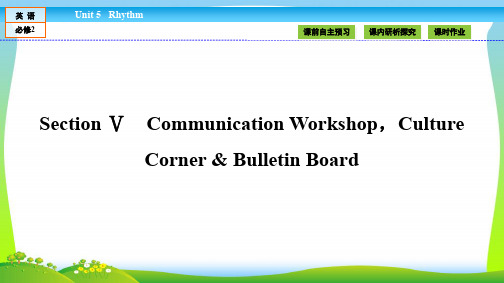
英语 必修2
Unit 5 Rhythm
课前自主预习 课内研析探究 课时作业
be related to 和……有联系;和……有亲戚关系 (教材 P32)It is closely related to the music of West Africa. 这与西非的音乐关系紧密。 (1)relate sth.to sth./sb.把……与……联系起来;向……讲述 (2)in relation to 关于;涉及 have (no) relation to 与……有(无)关
英语 必修2
Unit 5 Rhythm
课前自主预习 课内研析探究 课时作业
①I recommend you to obey the rules. 我劝你遵守规章制度。 ②He strongly recommended going there by train. 他强烈建议坐火车去那儿。 ③Our teacher recommends that we (should) take exercise regularly to keep fit. 我们老师建议我们应该经常锻炼以保持身体健康。 ④Would you recommend a good dictionary to me? 你能给我推荐一本好词典吗? ⑤I will recommend you for the position as my secretary. 我将推荐你做我的秘书(这份工作)。
英语 必修2
Unit 5 Rhythm
课前自主预习 课内研析探究 课时作业
①You are responisble for his behaviour. 你要对他的行为负责。 ②It is your responsibility to look after the children. 照看这些孩子是你的责任。 ③Who will take responsibility for the accident? 谁要为这次事故负责?
北师大版高中英语必修2 Unit 5《Rhythm》ppt重点小结课件

-1-
重点单 词
1.
adj.民间的
2.
n.
效果,作用
3.
vt.使失望 4.
n.表演;演奏
5.
vt.& vi.表演;做
6.
n.奖,奖品
7.
n.基地,基础
8.
adv.极端地,非常
地
9.
adj.创造性的,有创造力的 10.
adj.强大的,有力
的
11.
n.系统 12.
n.听众;观众
13.
vt.使(人)印象深刻
1)It is three years 他参军已有三年了。
the army.
2)People do not know the value of their health
it. 人们直至失去了健康才知其可贵。
3)
,he still would not eat.
尽管他饿了,但是他仍然不想吃。
2.Adverbial clauses(Ⅱ)—cause,result and purpose
④ 紧跟老师的推导过程抓住老师的思路。老师在课堂上讲解某一结论时,一般有一个推导过程,如数学问题的来龙去脉、物理概念的抽象归纳、语 文课的分析等。感悟和理解推导过程是一个投入思维、感悟方法的过程,这有助于理解记忆结论,也有助于提高分析问题和运用知识的能力。
⑤ 搁置问题抓住老师的思路。碰到自己还没有完全理解老师所讲内容的时候,最好是做个记号,姑且先把这个问题放在一边,继续听老师讲后面的 内容,以免顾此失彼。来自:学习方法网
重点单词
1.folk 2.effect 3.disappoint 4.performance 5.perform 6.award 7.base 8.extremely 9.creative 10.powerful 11.system 12.audience 13.impress 14.throughout 15.treasure bine 17.represent 18.general 19.quit 20.identity 21.root 22.appearance 23.transform 24.ordinary 25.generation 26.unique 27.immigrant 28.reaction 29.responsible 30.permission 答 重点短语 案 1.be used to e out 3.in other words 4.at times 5.in some ways 6.back and forth 7.at the end of 8.pick up 重点句型
北师大版高中英语必修二第5讲:Unit5Rhythm-词汇篇2(学生版)
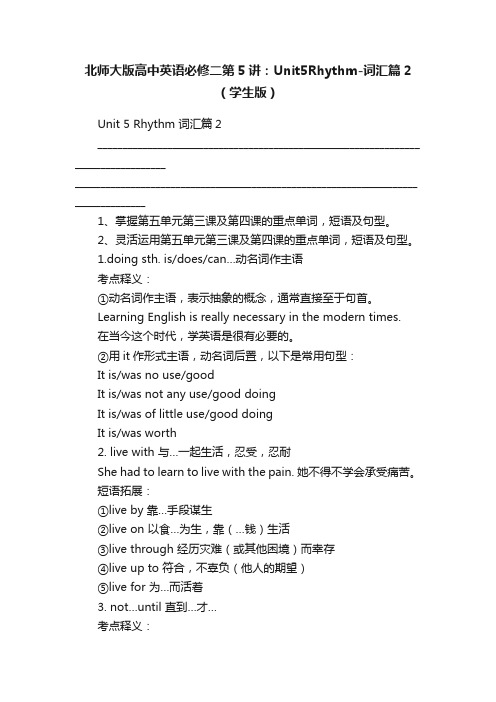
北师大版高中英语必修二第5讲:Unit5Rhythm-词汇篇2(学生版)Unit 5 Rhythm 词汇篇2________________________________________________________________ ______________________________________________________________________________________ ______________1、掌握第五单元第三课及第四课的重点单词,短语及句型。
2、灵活运用第五单元第三课及第四课的重点单词,短语及句型。
1.doing sth. is/does/can…动名词作主语考点释义:①动名词作主语,表示抽象的概念,通常直接至于句首。
Learning English is really necessary in the modern times.在当今这个时代,学英语是很有必要的。
②用it作形式主语,动名词后置,以下是常用句型:It is/was no use/goodIt is/was not any use/good doingIt is/was of little use/good doingIt is/was worth2. live with 与…一起生活,忍受,忍耐She had to learn to live with the pain. 她不得不学会承受痛苦。
短语拓展:①live by 靠…手段谋生②live on 以食…为生,靠(…钱)生活③live through 经历灾难(或其他困境)而幸存④live up to 符合,不辜负(他人的期望)⑤live for 为…而活着3. not…until 直到…才…考点释义:①Not until位于句首,主句用倒装语序。
Not until I have finished my task shall I be able to go to the movies. 直到完成任务我才能去看电影。
高中英语Unit5RhythmPeriodSixGrammar2课件北师大版必修2

3.“so+many/much/little/few+名词+that...”是习惯用法。 其中 so 不能用 such 替换。
He had so many things to do that务繁多,整天都很忙。
[即学即用 2] 完成句子 1.Ning Zetao swims ___s_o_f_a_s_t _th_a_t___ no one can catch up with him. 宁泽涛游得这么快以至于没有人能赶上他。 2.It is __su_c_h__fi_n_e_w__e_at_h_e_r_th_a_t___ we all want to go camping. 天气这么好以至于我们都想出去野营。 3.Tom is __s_o_k_i_nd__a_b_o_y__th_a_t/_s_u_ch__a_k_i_n_d_b_o_y_t_h_a_t they all like to make friends with him. 汤姆是这么好的孩子以至于他们都愿意跟他交朋友。
Unit 5
Rhythm
Period Six Grammar
单元语法(二)——状语从句(Ⅱ)
01 课前自主领悟
03 课后训练
02 课堂语法精讲
课时作业
01 课前自主领悟
[语法图解]
[语法感悟] 选词填空 in case, because, so that/in order that, for fear that, so...that 1.They set out early _____so__th_a_t_/i_n_o_r_d_e_r_th_a_t___ they might arrive in time. 2.__B_e_c_a_u_s_e__ there was so heavy fog, the vehicles were not allowed to travel onto the highway. 3.He runs _____s_o____ fast ___t_h_a_t____ no other can catch up with him. 4.Take an umbrella ______in__ca_s_e______ it rains. 5.He worked hard ___fo_r_f_e_a_r _th_a_t___ he might be fired by the boss.
高中英语必修2(北师大版)Unit 5 Rhythm 知识点总结

高中英语必修2(北师大版)Unit 5 Rhythm知识点总结一、重点词汇词义辨析:affect/effect/influence这些词均含“影响”之意,但在词性和意义上有差别。
ordinary这一工程带来的变化给我们留下了很深的印象。
Ever since my childhood, my father has been trying to impress on me the value of confidence for one's success.从童年开始,父亲就一直试图让我记住信心对一个人成功的价值。
拓展:1. impression n. 印象leave/give/make an impression on sb.:给某人留下印象2. impressive adj. 令人印象深刻的in some ways :在某些方面Tom was in some ways a younger clone of his handsome father.汤姆某些地方长得和他那帅气的父亲一模一样,只是年轻一些。
拓展:与in some ways 结构很相似的表达方式还有:in many ways,意为:在很多方面。
In many ways children live, as it were, in a different world from adults.从许多方面讲,小孩子可以说是生活在一个跟成人不同的世界里。
in other words:换言之,换句话说(=namely, that is)The mobile library services have been reorganized — in other words, they visit fewer places.流动图书馆服务重新作了安排,—换句话说,他们去的地方减少了。
combine sth. with sth.:将某物与某物相连It's no easy task to combine family responsibilities with a full-time job.将家庭责任与全职工作结合起来不容易。
- 1、下载文档前请自行甄别文档内容的完整性,平台不提供额外的编辑、内容补充、找答案等附加服务。
- 2、"仅部分预览"的文档,不可在线预览部分如存在完整性等问题,可反馈申请退款(可完整预览的文档不适用该条件!)。
- 3、如文档侵犯您的权益,请联系客服反馈,我们会尽快为您处理(人工客服工作时间:9:00-18:30)。
Unit 5 Rhythm 语法篇____________________________________________________________________________________________________________________________________________________________________1、状语从句(I)—时间和让步2、状语从句(II)—原因,结果和目的在复合句中修饰主句或主句中的某一部分作状语的从句叫状语从句。
状语从句通常由从属连词或起连词作用的词组引导。
状语从句根据它表达的意思不同,可分为时间、地点、原因、目的、结果、条件、方式、比较、让步九类。
一,时间状语从句:主要由when, whenever, after, before, as, (ever)since, as soon as, (not) until, while,immediately, the moment等连词引导。
1.when, while, as(当…时)的用法区别①当主句谓语动词表示短暂动作,从句中的谓语动词有持续性特征时,这三者可以互换。
例:I got the news on the radio when/while as/ I was having breakfast.②当主,从句的谓语动词都表示非持续性动作,而且两个动作几乎同时发生时,不用while, 可用when和as。
例:I met as/when I was getting off the bus.③当从句的动作发生在主句的动作之前,只能用when引导从句,不可用as或while。
例:When you have finished your work, you may have a rest.④当主句谓语动词是be doing/be about to do/had done时只能用when, when在此时相当于and at that moment就在那时。
例:They were watching the World Cup when suddenly the lights went out.⑤当主、从句的动作同时发生时,或表示对比关系,用while。
例:She thought I was talking about her daughter, while in fact, I was talking about my daughter.⑥as表示“随着”例:As time goes on, it’s getting warmer and warmer.2.表示“一…就…”的结构Hardly/scarcely…when, no sooner…than和as soon as例:I had hardly/scarcely got home, when it began to rain.I had no sooner got home than it began to rain.As soon as I got home, it began to rain.注意:如果hardly, scarcely或no sooner置于句首,句子必须用倒装结构。
例:Hardly/Scarcely had I got home when it began to rain.3.比较until和till①until/till用于肯定句时,表示“直到…为止”,主句必须为持续性动词。
例:We shall wait until/till he comes.②not until/till表示“直到…才”,主句通常要用短暂性动词,这时until和till可用before代替。
例:I didn’t leave until/till/before she came back.③当not until位于句首时,主句中的主语,谓语要使用倒装语序。
例:Not until she stopped crying did I leave.注意:until引导的从句可以放在主句之前或主句之后,但till从句一般不放在句首。
4.名词词组引导的时间状语从句,如:every time(每次),the next time(下次),the moment(一…就),the instant(一…就),the second(一…就),the day(那天)等。
I didn’t have a penny the last time I saw you.5.since和before的用法比较:两者均可用于“It + be…+since/before+从句”的句型。
区别是since表“自从…以来”,其结构是:It is/has been some time since sb. did sth.; It was some time since sb. had done sth.。
而before的含义是“过了多久才…”,结构是:It will be some time before sb. do(es) sth.; It was/had been some time before sb. did sth.。
例:It is three years since he joined the army.二,让步状语从句让步状语从句表示在某种相反的条件下,主句中的情况依然会出现。
让步状语从句由although, though, as, while, however, whatever, whoever, whomever, whichever, whenever, wherever, whether…or…, no matter(who, what, etc), even if, even though等词或短语引导。
①although/though这两个词意思是一样,都意为“虽然,尽管”。
although比though正式。
although, though 不能与but连用,但是可以与yet, still, nevertheless连用。
而while突出主句和从句的对比。
例:Although/Though he blames me, yet I will trust him.②even if, even though这两个词语气比though, although强,意为“即使”,两者可以通用。
例:We won’t be discouraged even if/though we fail ten times.③however, whatever, whenever, wherever相当于no matter(how, what, when, where, etc),这几个词引导的让步状语从句语气十分强烈。
No matter how busy he was, he studied English every day.④连词as同though一样,也可以引导让步状语从句,但从句中要用特殊语序。
例:Children as he is, he knows a lot.三,原因状语从句原因状语从句是表示原因和理由的从句。
引导原因状语从句的有as, because, since, now(that), considering that, seeing that等。
①because, since, as, for的区别because语气最强,表示产生某结果的直接原因,一般置于主句之后,也可以放在主句之前,用逗号隔开,在回答why引导的特殊疑问句时,只能用because。
例:You shouldn’t get angry only because some people speak ill of you.since往往表示的是已知的客观事实,或分析后的推理,引导的从句大多置于句首,语气比because 弱。
例:Since you’re not interested, I won’t tell you about it.as表示的理由最弱,只是对主句的附带说明,重点在主句。
as从句通常放在主句前。
例:As you are unable to answer, perhaps we should ask someone else.for是并列连词,只用于连接表示原因的分句,因此不能用于句首。
The day breaks, for the birds are singing.注意:because不能与so连用②now(that)(既然,因为),considering that, seeing that(鉴于…的事实,考虑到…),in that(在于,由于)例:Now (that) dinner is ready, go and wash your hands.四,目的状语从句目的状语从句是表示行为目的的从句。
引导目的状语从句的主要连词有so that, in order that, in case, for fear that等。
①in order that与so that表示“为了,以便,”一般放在主句之后,in order that也可放在句首。
从句中常常使用一些情态动词,如can, could, may, might, should等。
例:I will speak slowly so that you can understand.注意:当主从句的主语一致时,so that和in order that引导的目的状语从句可以转换成相对应的动词不定式结构。
例:We got up early so that we would arrive in time.=We got up early so as to arrive in time.②in case, for fear that都表示“以免,以防,唯恐”,含有否定意义。
Better take more clothes in case the weather is cold.五,结果状语从句结果状语从句是表示事态结果的从句。
引导结果状语从句的连词有:so that, so…that, such…that等。
结果状语从句经常至于主句之后。
1.so that, such that。
其中so that最为常用,so或that常用于口语或非正式文体中;such that可以连用,意思是“如此…以至于”。
例:What has happened that you look so worried?2.so…that如此…以至于…。
其引导的结果状语从句有如下四种结构:①so+形容词/副词+that从句例:The village is so small that it cannot be shown in the map.②so+形容词+a/an+单数名词+that从句例:It was so hot a day that they all went swimming.③so+ many/few+复数名词+that从句例:I have had so many falls that I’m black and blue all over.④so+ much/little+不可数名词+that从句例:I had so little money then that I couldn’t even afford a used car.3.such…that如此…以至于…。
